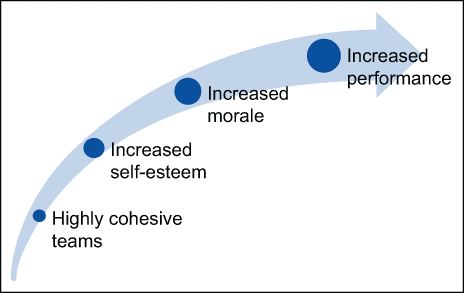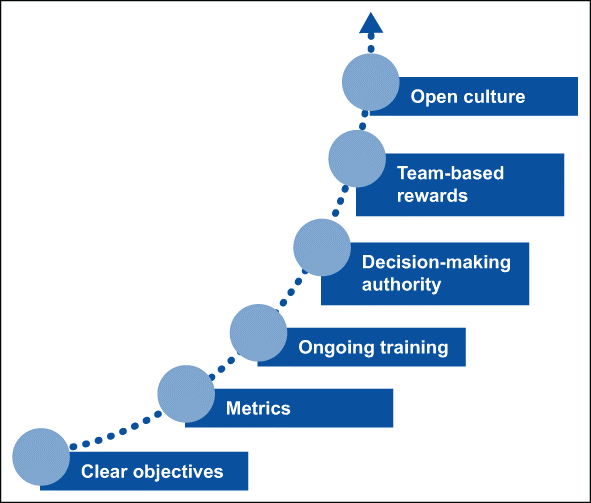Social Cohesion
Social cohesion refers to positive social relationships – it is the bond or ‘glue’ that binds the group together. A socially cohesive group is one that works towards the wellbeing of all its members, fights exclusion and marginalization, creates a sense of belonging, promotes trust and offers its members the opportunity of positive progress.

Cohesion is the degree to which group members come together as one unit to reach a common goal. Members of cohesive groups see themselves as one entity rather than a collection of individuals. Group members have positive regard for one another and get along well. They listen to and trust one another and respect each other’s opinion even if they disagree. It is a feeling of deep loyalty and togetherness and includes the degree to which each individual has made the group’s goal his or her own.
The productivity of groups is strongly related to their cohesiveness. In fact, research has shown that cohesive groups perform better than non-cohesive groups in decision-making activities. As a manager, it is critical for you to understand ways to increase cohesiveness in the groups that you lead. One way to improve group cohesion is through team building activities.
Description
The concept of social cohesion has a relatively recent history.
Like all social concepts, there is no one agreed definition of social cohesion. But there are some common elements. Note the emphasis on shared values, common enterprises, shared challenges, a sense of community. And note that, while social cohesion can be regarded as property – like something a group has or possesses – it can also be understood as a process. It is not simply a result of something, but something for which a community continually strives. Explaining it in more scholarly terms, social cohesion is regarded as an independent variable – something that determines a social result; for others, social cohesion is a dependent variable – it is the result of actions elsewhere.
For our purposes, it is important to simplify – to ensure that social cohesion isn’t just a concept with value only for training debates
Social cohesion is the set of characteristics that keep a group able to function as a unit, often through common values, beliefs, and behaviors. What constitutes group cohesion really depends on whom you ask, but in our case most depends on the trainer.
Building social cohesion into the group depends on these 5 elements:
- Understand – we need to understand the needs of participants, we have to adapt to their level of knowledge and arrange accordingly
- Engage – In order to understand deeper, we need to engage in the group and that will help them to understand us too. We need to build long term trust and to keep track of the changes that are willing to come up by the time.
- Prevent – Prevent and respond to incidents of discrimination or conflict between the group
- Plan – A plan for actions to build social cohesion needs a focus and should meet the specific needs of the group.
- Monitor – we should constantly make an effort to monitor the group cohesion to ensure the group is on the right path.
First, creating and maintaining group cohesion requires attention to create special bonds of solidarity.
Second, and as a result, social cohesion involves a definition of who is “in” and who is not, to whom members of group owe solidarity and those to whom they do not. The borders of social inclusion and exclusion are therefore often analyzed within a framework that deploys the concept of social cohesion.
Third, social cohesion is considered to require and be based on shared values. Therefore, even if many define social cohesion in terms of values and collective identities, that is, the feeling of belonging to a group, whether local or national, many discussions also see social cohesion being related to the economic level of belonging.
What is group cohesion?
Group cohesion is a phenomenon that determines how well a group holds together. When the cohesion is strong, the group will remain stable, but when it is weak, the group may fall apart. The study of group cohesion is a topic of interest among social psychologists and many others, including people who are concerned with making large organizations work effectively. Understanding this phenomenon can be key to pulling together a team, a workplace, or a similar group of people.
Some of the factors in how a group holds together are social. Many things can occur within a group and its members that encourage people to stay in the group and to stay focused on group goals. Others are environmental, caused by external factors that make staying together as a group more or less appealing.
In many cases, the smaller a group is, the better the cohesion. The more stable a group is in terms of member demographics, the better the cohesion as well. People who share characteristics like gender, race, sex, religion, and so forth will typically forge stronger connections in a group, while a group of diverse individuals may have difficulty staying together. Another factor is group success, with people having an incentive to stay in a group that is doing well, with elitism also playing a role.
Members of a highly cohesive team focus on the process, not the person; they respect everyone on the team, assuming good motives; and they fully commit to team decisions and strategies, creating accountability among the team. Morale is also higher in cohesive teams because of increased team member communication, friendly team environment, loyalty and team member contribution in the decision-making process.

Although cohesiveness is a crucial and determinant factor for team effectiveness, cohesiveness alone will not guarantee success without organizational commitment. Team members can feel cohesion with their teammates but be completely detached from organizational values and vice versa.
Highly effective teams must have both perceived team support (PTS) and perceived organizational support (POS), but their PTS must be higher than their POS. PTS can be defined as the “degree to which employees believe that the team values their contribution and cares for their well-being.” POS can be defined as “the extent to which employees believe that the organization values their contribution and cares about their well-being.”3
Above and beyond cohesiveness other subset factors are important in team development to make teams work, as shown below and in the picture below:
- A clear set of objectives, communicated explicitly by management
- Metrics allowing team members to evaluate their performance and the connection between the work of the team and key business indicators
- Ongoing training
- Decision-making authority necessary to reach business goals
- Team-based rewards and appraisal, not only individual incentives
- An open culture with easy access to relevant information and senior management as needed

Building Cohesive Group
No matter if you’re building a group for the first time, or just trying to refine the process, here are few ways to successfully build a cohesive team:
Establish a mission. The most important factor is to determine your team’s mission before selecting members. Decide the goals of the group and how you will accomplish those goals. Then select team members who will contribute best to the mission.
Look for diversity. The most successful teams require diversity. Diverse teams have access to many people with varying skills and experiences. A diverse group will be able to pull from all these experiences in order to achieve the mission.
Practice teamwork. Team-building exercises are the best way to see how individual members will work together to accomplish a goal. Before your team has to work on important tasks, see how they handle something simple like an ice breaker. Who took the lead? Who worked well together? Use what you observe and apply it to the real mission. Plus, your team members will bond with each other in the process.
Utilize individual strengths. Determine the strengths of each team member and assign them to specific tasks based on their strengths. Delegating based on strengths is the best way for the group to accomplish its goals. Be clear about what each member is responsible for and hold them accountable.
Communicate effectively. A team cannot be cohesive if communication is ineffective. Make sure to methods of communication are consistent. Clearly explain the team’s instructions and goals. Make sure all messages are constructed for the benefit of the team.
Give feedback. Throughout a project and after a project is complete, you need to give your team feedback. This should be a combination of individual feedback and for the team as a whole. Explain what worked well, what didn’t, and the results of their project. Constructive feedback will make for a more cohesive team during the next project.
Ask for feedback. Not only should you give your team feedback, but also you should ask them to give it to you. Ask what they thought worked well and not so well. Multiple opinions can really shine a light on flaws in the process. Plus, your team members will feel like their opinion matters when you take it into account for next time.
Celebrate success. When your team successfully accomplishes the mission you established at the beginning, it’s important to recognize them for it. Make sure the group knows that you appreciate their work and thank them.
Building a cohesive team is a never-ending process. With every new project/training comes different challenges. It is important to consistently make sure your group is working well together and reaching results effectively.
Teams drive organizational success, though developing and leading high-performance teams is one of the most complex tasks facing any leader in the current competitive work environment. Cohesiveness is the key factor in implementing effective, high-performance teams. Emotional intelligence also plays a key role in building high-performance teams in that emotional intelligence fosters cohesiveness. Managing emotions is how you build a team, an organization. It is the ability to get team members inspired. Leaders must understand how team cohesiveness works and how bonding in a team will build energy. Leaders must inspire group members through reinforcing the sense of belonging, empathy in bonding and mutual respect, in addition to giving people choice and power over what they can do. Once that sense of support, that foundation, is created, the result is limitless creativity.
Why did I choose this tool?
The training that contributes to a socially cohesive group, requires a focus on both, trainer and participants. There is a significant relationship between social cohesion and inclusion, which contributes to successful work, presence and active participation in the training. On one hand, we, as trainers have to create an atmosphere of belonging to the group. On the other hand, it is a big responsibility not to over jeopardized the method to the other end, which makes the participants uncomfortable. We just need to recognize the contribution of each participant of the group and to motivates for more.
Suggested Reflection Questions
Exercises:
To show and/or explain social cohesion in a group, almost any kind of team building activity can help. Here is one example:
Trust Circle
An exercise that requires a great deal of trust between the members of the circle and the person inside the circle. Start in small circles.
Form groups of six or seven, using participants of roughly the same size.
One participant stands in the center of the circle and stands firm. The other participants provide support by putting two hands on the center participant.
When the center participant is ready and has eyes closed and body rigid like a plank of wood, that participant gently leans backwards and is then passed around and across the circle.
After a while, the group gently brings the participant’s body back to a central, upright position.




